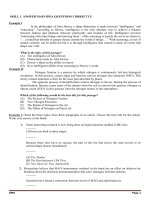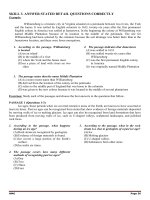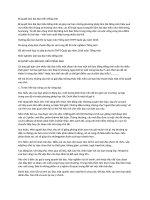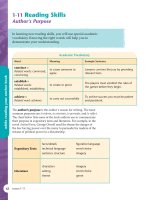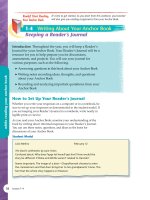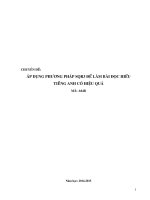Bài đọc hiểu tiếng anh
Bạn đang xem bản rút gọn của tài liệu. Xem và tải ngay bản đầy đủ của tài liệu tại đây (102.36 KB, 11 trang )
1. Hãy đọc đoạn văn sau và chọn câu trả lời tốt nhất trong số A, B, C và D.
TRAFFIC IN OUR CITIES
The volume of traffic in many cities in the world today continues to expand. This
causes many problems, including serious air pollution, lengthy delays, and the greater
risk (1) _______ accidents. Clearly, something must be done, but it is often difficult to (2)
_______ people to change their habits and leave their cars at home.
One possible (3) _______ is to make it more expensive for people to use their cars by
(4) _______ charges for parking and (5) _______ tougher fines for anyone who (6)
_______ the law. In addition, drivers could be required to pay for using particular routes
at different times of day. The system, (7) _______ as “road pricing”, is already being
introduced in a (8) _______ of cities, using a special electronic card (9) _______ to the
windscreen Of the car.
Another way of (10) _______ with the problem is to provide cheap parking on the
(11) _______ of the city, and strictly control the number of vehicles allowed into the
centre. Drivers and their passengers then use a special bus service for the (12) _______
stage of their journey.
Of course, the most important (13) _______ is to provide good public transport.
However, to get people to (14) _______ the comfort of their cars, public transport must
be felt to be reliable, convenient and comfortable, with fares (15) _______ at an
acceptable level.
1.
2.
3.
4.
5.
6.
7.
8.
9.
10.
11.
12.
13.
A. of
A. make
A. approach
A. enlarging
A. carrying down
A. crosses
A. named
A. quantity
A. fixed
A. doing
A. outskirts
A. late
A. thought
B. for
B. arrange
B. manner
B. increasing
B. putting off
B. refuses
B. seen
B. number
B. joined
B. handling
B. border
B. end
B. thing
C. about
C. suggest
C. custom
C. growing
C. bringing in
C. breaks
C. called
C. total
C. built
C. dealing
C. outside
C. complete
C. work
D. by
D. persuade
D. style
D. developing
D. taking away
D. cracks
D known
D. sum
D. placed
D. solving
D. limit
D. final
D. event
14.
15.
A. pass on
A. taken
B. throw away C. give up
B. kept
C. given
D. leave out
D. stood
2. Hãy đọc đoạn văn sau và chọn câu trả lời tốt nhất trong số A, B, C và D.
AUDIOBOOKS - BOOKS ON CASSETTE
In the modern world, there is a wealth of leisure activities to choose from.
Entertainment industries (1) _______ for your leisure time. You can watch TV, listen to
music, go to an art gallery or concert or, of course, read a book. Sometimes it seems that
reading is (2) _______ because, (3) _______ you’re a fast reader, it can take a (4)
_______ amount of time to finish a novel, for example. But in the (5) _______ world,
time is something that can be in short supply.
Book publishers haven’t been (6) _______ to realise this and are now selling a
product which needn’t (7) _______ as much of your time but still tells you an excellent
story. The new product is the audiobook-cassette recordings of shortened novels, often
read by well-known personalities or the authors themselves. Audiobooks are (8) _______
new but people are becoming more aware of them and sales are increasing (9) _______.
One of the attractions of audiobooks is that they’re (10) _______ listening to the
radio, only better. You can listen to what you want when you want, and you won’t ever
(11) _______ anything. Much of their appeal (12) _______ in their flexibility. They (13)
_______ you to do other things while you’re listening, such as driving or (14) _______
the housework For some people, audiobooks can be a much more enjoyable way of (15)
_______ knowledge than reading.
1.
2.
3.
4.
5.
6.
7.
8.
9.
10.
11.
12.
A. chase
A. neglected
A. in spite
A. plentiful
A. current
A. behind
A. take up
A. partly
A. ever since then
A. as
A. pass
A. stands
B. compete
B. declined
B. no matter
B. broad
B. new
B. slow
B. fill out
B. approximately
B. all the time
B. same
B. lack
B. belongs
C. oppose
C. lessened
C. regardless of
C. considerable
C. present
C. delayed
C. go through
C. roughly
C. up until now
C. like
C. miss
C. bases
D. pursue
D. disposed
D. even if
D lasting
D. modern
D. overdue
D. pass by
D. relatively
D. from then on
D. both
D. lose
D. lies
13. A. grant
14. A. doing
15. A. grasping
B. allow
B. running
B. catching
C. spare
C. making
C. gaining
D. afford
D. cleaning
D. raising
3. Hãy đọc đoạn văn sau và chọn câu trả lời tốt nhất trong số A, B, C và D.
THE PATHE FILM COMPANY
In 1885, a Frenchman, Charles Pathe, created what later became France’s most
successful film studios. By 1907, the company had expanded enormously and had studios
in France, Britain, Germany, Italy, Spain and the USA What seems surprising now that
Hollywood dominates the film (1) _______ is that a French company (2) _______ itself
so well in the USA. Pathe was one of the main film companies there at that (3) _______,
hiring out its studios to other film-making companies (4) _______ distributing its own
films.
However, (5) _______ Pathe was big in the USA, it was a giant Europe. In 1913, the
year before the First World War (6) _______, Pathe made no fewer than three hundred
films. But the war affected the company (7) _______. Shortage of staff and equipment
led to big (8) _______ in production, and by 1918 output had (9) _______ to sixty-three
films. From then on, Pathe (10) _______ on making fewer films of (11) _______ length
and better quality.
Pathe was the first company to put out regular new films, which it started doing in
1903 Each film lasted fifteen minutes and (12) _______ of six new items From (13)
_______ on, Pathe’s news department had branches all over Europe and later all over the
world. By the 1970s, TV news had completely (14) _______ the role of cinema news film
and so the company stopped making them. Today, Pathe is chiefly (15) _______ in TV,
cinema and new video technology.
1.
2.
3.
4.
5.
6.
7.
8.
A. life
A established
A date
A. in addition
A so
A. burst out
A badly
A. chops
B. world
B. set
B. phase
B. together
B. whether
B. broke out
B. extremely
B slips
C. area
C. founded
C. age
C. as well as
C. despite
C. set off
C. largely
C. cuts
D. channel
D. placed
D. time
D. also
D. if
D. went off
D. highly
D. dips
9.
10.
11.
12.
13.
14.
15.
A. descended
A. thought
A. further
A. consisted
A. soon
A. brought off
A. involved
B. shortened
B. engaged
B. greater
B. featured
B. firstly
B turned into
B. connected
C. fallen
C. occupied
C. higher
C. included
C. early
C. caught on
C. linked
D. subtracted
D. concentrated
D. bigger
D. composed
D. initially
D. taken over
D. tied
4. Hãy đọc đoạn văn sau và chọn câu trả lời tốt nhất trong số A, B, C và D.
MARKETS
In practically any country in the world, you are (1) _______ to find a market
somewhere. Markets have been with us since (2) _______ times, when people became
self-sufficient and needed to exchange the goods they produced. For example, a farmermight have exchanged a cow (3) _______ tools and so on. But just as times have (4)
_______, so have market practices. So, (5) _______ in early times the main activity (6)
_______ with markets would have been “bartering”, meaning the exchange of goods as
described (7) _______, today most stall-holders wouldn’t be too (8) _______ on
accepting potatoes as payment, for instance, instead of cash.
In contrast, what might be a common (9) _______ in a modern market is a certain
amount of “haggling”, where customers and sellers eventually (10) _______ on a price,
after what can sometimes be quite a heated debate. This has become so popular in certain
places that many people think that this is what makes the (11) _______ atmosphere of a
market. But (12) _______ as no two people are the same, no two markets are the same
either, and so behaviour which is expected in one market in one country may not be (13)
_______ in another. Even within one country, there are those markets where you can
haggle quite (14) _______ and those where you would be (15) _______ not to try!
1
2.
3.
4.
5.
6.
7.
8.
A. safe
A. ancient
A. into
A. changed
A. however
A associated
A. over
A. fond
B. confident
B. antique
B. by
B. turned
B despite
B. relating
B. above
B, keen
C. definite
C. old
C. for
C. developed
C nevertheless
C. connecting
C. upper
C. eager
D. sure
D. past
D. over
D. differed
D. whereas
D. attached
D. higher
D. pleased
9
10.
11.
12.
13
14.
15.
A. look
A confirm
A. sole
A even
A. acceptable
A simply
A. informed
B. appearance
B: consent
B. single
B so
B convenient
B. plainly
B. advised
C. sight
C. approve
C. only
C. just
C. comfortable
C. clearly
C. noticed
D. view
D. agree
D. unique
D. such
D. receptive
D. easily
D. suggested
5. Hãy đọc đoạn văn sau và chọn câu trả lời tốt nhất trong số A, B, C và D.
GARETT A MORGAN
An accident between a car and a horse-drawn carriage turned on a green light in the
mind of one witness to it. Why not, thought Garrett A Morgan, design a signal that would
(1) _______ the movement of road traffic? (2) _______ a result, in February 1927
Morgan produced the world’s first automatic electric traffic signal.
His invention (3) _______ of a pole with two arms that turned round to (4) _______
when traffic should move. The words “stop” and “go” were on different sides of the arms,
which automatically turned and (5) _______ the right line of traffic when necessary.
Morgan who had been (6) _______ about road safety because of the (7) _______
number of cars coming on to the roads at the (8) _______, sold his invention to the
General Electric Company for $40,000.
Morgan was born in Kentucky in 1877 and (9) _______ an elementary education. In
1905 he began a job (10) _______ sewing machines and in 1907 he (11) _______ his
own shop for this. He (12) _______ on to start a company.selling hair treatments and later
he invented the “safety hood”, which (13) _______ firemen from gas and smoke and (14)
_______ a prize at a 1914 exhibition.
Morgan died in 1963, just months after being (15) _______ by the US government
with an award for inventing the first automatic traffic signal.
1.
2.
3.
4.
5.
6.
7.
A. direct
A. With
A. composed
A. declare
A. aimed
A. tense
A. raising
B. train
B. Being
B. combined
B. indicate
B. opposed
B. restless
B. increasing
C. master
C. As
C. constructed
C. sign
C. viewed
C. excited
C. enlarging
D. rule
D. By
D. consisted
D. inform
D. faced
D. concerned
D. heightening
8.
9.
10.
11.
12.
13.
14.
15.
A. while
A. received
A. remedying
A. opened
A. took
A. covered
A. reached
A. respected
B. period
B. attained
B. mending
B. introduced
B. went
B. prevented
B. caught
B. honoured
C. time
C. gathered
C. revising
C. installed
C. kept
C. saved
C. won
C. approved
D. age
D. took
D. correcting
D. formed
D. got
D. protected
D. succeeded
D. valued
6. Hãy đọc đoạn văn sau và chọn câu trả lời tốt nhất trong số A, B, C và D.
EYEWITNESS GUIDES
It all started just six years ago with Birds. Since then, Eyewitness Guides have
become a publishing sensation - 50 subjects (1) _______, 40 countries conquered, 15
million copies sold. But the success of Eyewitness Guides cannot be (2) _______ in
statistics alone, (3) _______ these high-quality reference books have established a (4)
_______ original way of presenting information.
We live in an age of television, video and interactive computing, in which children are
(5)
at absorbing data from images at a glance. (6) _______ this makes them respond
favourably to visual learning, the disadvantage is that they sometimes lack confidence
with words. So, what the Eyewitness Guides have done is to combine the two elements,
words, and pictures, (7) _______ them as just one thing - entertainment.
One of the main reasons (8) _______ the books’ success is the discovery that, against
a white background, even the most (9) _______ objects can look wonderful. Often a
single photographic image will take (10) _______ an entire double-page spread, grabbing
your (11) _______. Whatever the image, you’ll always find the text (12) _______
alongside, building your understanding of the subject.
Eyewitness Guides are the (13) _______ of the unique approach, in which
photographs, models, maps and diagrams are specially produced. Everything is done to
make (14) _______ that they compete with the impact of television images. But these
books have one (15) _______ advantage - children can return to them again and again,
finding something fresh to read every time.
1.
A. dealt
B. fulfilled
C. covered
D. managed
2.
3.
4.
5.
6.
7.
8.
9.
10.
11.
12.
13.
14.
15.
A. scored
A. for
A. fully
A. capable
A. In contrast’
A. conducting
A. under
A. accustomed
A. up
A. fascination
A. quite
A. outcome
A. certain
A. high
B. valued
B. out of
B. completely
B. powerful
B. While
B. treating
B. behind
B. habitual
B. in
B. involvement
B. nearby
B. production
B. definite
B. large
C. numbered
C. due to
C. considerably
C. effective
C. Even so
C. operating
C. beneath
C. repeated
C. to
C. attraction
C. right
C. formation
C. firm
C. major
D. measured
D. from
D. widely
D. skilled
D. Despite
D. applying
D. below
D. familiar
D. on
D. attention
D. next
D. effect
D. guaranteed
D. grand
7. Hãy đọc đoạn văn sau và chọn câu trả lời tốt nhất trong số A, B, C và D.
BOWLS
If you can roll a ball, you can play bowls. Everyone can play: young and old, men and
women, the fit and the not so fit. It is the one outdoor game that (1) _______ is a sport for
all. What other sport can grandparents play on (2) _______ terms with their
grandchildren? What other game is so simple that you could take it up today and be (3)
_______ in the national championships tomorrow?
Simple? Perhaps that’s not the (4) _______ word. There are bowls players in their
thousands who will tell you that, although bowls is a game that anyone can (5) _______
in. five minutes, it takes a lifetime to (6) _______ it. They are the people who have (7)
_______ a passionate interest in the game. (8) _______, for outsiders, bowls is another
world, and strange and puzzling one. They see a bowls game in (9) _______ and wonder
what is going on.
What the players are trying to do is easy to explain. Their (10) _______ is to roll their
bowls, called woods, as near as possible to the little white ball, called the jack. If one of
your bowls finishes nearer to the jack than your (11) _______, you score one point and he
or she scores nothing. If you have the two nearest, you score two, and (12) _______. The
skill (13) _______ in rolling a bowl that weighs around 2 kilos across about 40 metres so
that it stops only a very short (14) _______ from the target is just as (15) _______ as the
skills required in other sports.
1.
2
3.
4.
5.
6.
7.
8.
9.
10.
11.
12.
13.
14.
15.
A. exactly
A. alike
A. competing
A. right
A catch on
A. manage
A. assembled
A. Besides
A performance
A. point
A. competitor’s
A. further
A. involved
A distance
A. respectable
B. really
B. equal
B. entering
B suitable
B. see through
B tame
B. produced
B. Unlike
B. movement
B. attempt
B. opponent’s
B so on
B. connected
B. extent
B. impressive
C. precisely
C. parallel
C. getting
C. genuine
C. find out
C. master
C.’ developed
C. However
C. practice
C scheme
C. contestant’s
C. moreover
C relating
C range
C. appreciative
D. accurately
D. matching
D. going
D. just
D pick up
D control
D. grown
D. Although
D action
D aim
D. opposer’s
D. as follows
D. belonging
D length
D. favourable
8. Hãy đọc đoạn văn sau và chọn câu trả lời tốt nhất trong số A, B, C và D.
THE QE2
Samuel Cunard’s first ship, the Britannia, made its first voyage from Liverpool in
England to the US in 1850. In those days there was little choice about (1) _______ of
travel. Anyone who (2) _______ to go to the US from Britain had to sail across the.
Atlantic. (3) _______ that, there was no way of getting there. The Britania was (4)
_______ a mail ship, but it also (5) _______ passengers. On that first (6) _______, as
records show, there was a (7) _______ of 63 of them, including Samuel Cunard and his
daughter and (8) _______ for that time, the ship had private bathrooms.
But Samuel Cunard would find it hard to (9) _______ much similarity between his
beloved Britannia and the Cunard company’s most famous liner today, the QE2, named
after Queen Elizabeth II of England. The Britannia is (10) _______ to have had two
members of staff (11) _______ every passenger. The passengers probably didn’t sleep in
cabins as comfortable and with as much (12) _______ as rooms in a good (13) _______
of hotel, as they do on the QE2 today.
The QE2 (14) _______ on her first voyage across the Atlantic from Southampton on
the south coast of England on May 2 1969. Five days later, she arrived in New York to an
enthusiastic (15) _______. Since that day she has carried over one and a half million
passengers around the world.
1.
2.
3..
4.
5.
6.
7.
8.
9.
10
11
12
13
14
15
A. procedures
A. thought
A. Apart from
A. at most
A. fetched
A. incident
A. total
A. distinctly
A. see
. A. doubtful
. A. to
. A. breadth
. A. level
A set off
A. meeting
B processes
B. wished
B. Else
B. above all
B. brought
B. occasion
B. sum
B differently
B. know
B. improbable
B. with
B. space
B. status
B. went away
B. applause
C. courses
C. dreamed
C. Instead of
C. overall
C. took
C. event
C. number
C. extremely
C. tell
C. uncertain
C. by
C. extent
C. class
C. got out
C. welcome
D. means
D. fancied
D. Otherwise
D. vastly
D. sent
D. circumstance
D. quantity
D. remarkably
D. catch
D. unlikely
D. of
D. expansion
D. rank
D. came along
D. acceptance
9. Hãy đọc đoạn văn sau và chọn câu trả lời tốt nhất trong số A, B, C và D.
INTELLIGENT TESTS
School exams are, generally speaking, the first kind of tests we take. They find out
how much knowledge we have (1) _______. But do they really show how intelligent we
are? After all, isn’t it a (2) _______ that some people who are very successful
academically don’t have any (3) _______ sense?
Intelligence is the speed (4) _______ which we can understand and (5) _______ to
new situations and it is usually tested by logic puzzles. Although scientists are now
preparing (6) _______ computer technology that will be able to “read” our brains, (7)
_______ tests are still the most popular ways of measuring intelligence.
A person’s IQ is their intelligence (8) _______ it is measured by a special test. The
most common IQ tests are (9) _______ by Mensa, an organization that was founded in
England in 1946. By 1976 it (10) _______ 1,300 members in Britain. Today there are
44,000 in Britain and 100,000 worldwide, (11) _______ in the US.
People taking the tests are judged in (12) _______ to an average score of 100, and
those who score over 148 are entitled to join Mensa. This (13) _______ at 2% of the
population. Anyone from the age of six can take the tests. All the questions are
straightforward and most people can answer them if (14) _______ enough time. But
that’s the problem-the whole (15) _______ of the tests is that they’re against the clock.
1.
2.
3.
4.
5.
6.
7.
8.
9.
10.
11.
12.
13.
14.
15.
A. fetched
A. case.
A. natural
A. on
A accord
A. advanced
A. at this age
A. how
A. appointed
A. held
A. largely
A concern
A. adds up
A. allowed
A. reason
B. gained
B. fact
B. bright
B. to
B. react
B. forward
B. for the present
B. that
B. commanded
B. had
B. enormously
B. relation
B. turns to
B. spared
B. point
C. attached
C. circumstance
C. sharp
C. in
C. answer
C. ahead
C. at the time
C. as
C. run
C. kept
C. highly
C regard
C. comes up
C. let
C. matter
D. caught
D. truth
D. common
D. at
D. alter
D. upper
D. now and then
D. so
D. steered
D. belonged
D. considerably
D. association
D. works out
D. provided
D. question
10. Hãy đọc đoạn văn sau và chọn câu trả lời tốt nhất trong số A, B, C và D.
THE MUSEUM OF CHILDHOOD
There are 4,000 toys in London’s Museum of Childhood, but it is not essential to be a
child to enjoy it. Most of the older toys were (1) _______ to be played with by adults.
All the toys (2) _______ in a beautiful glass-topped building in the East End of
London -but it wasn’t built for them. It was opened in 1872 and displayed art, shoemaking and furniture (3) _______.It wasn’t until 1974, when the children’s section had
(4) _______ enormously, that the (5) _______ building was officially devoted to the
history of childhood.
Once upon a time every toy was home-made, although by the late 1700s a huge toy
industry had (6) _______. Many home-made toys were made of metal and wood and a
few of these have (7) _______ well enough for the museum to display. It even has one of
the oldest dolls’ houses still (8) _______, made in 1673. There is something for everyone,
including the 18lh century toy theatre and the miniature Chinese gardens, (9) _______
tiny animals. Whichever is your favourite, each exhibit enables you to catch a (10)
_______ of the people and world it was made for.
The 35 or (11) _______ workers at the museum take (12) _______ care to make sure
that all of the exhibits are preserved in good working (13) _______. And (14) _______
the 500 new toys that move in every year from all over the world-nobody has ever heard
a (15) _______ one complaining.
1.
2.
3.
4.
5.
6.
7.
8.
9.
10.
11.
12.
13.
14.
15.
A. aimed
A. live
A. gatherings
A. risen
A. total
A. developed
A. maintained
A. being
A. containing
A. glimpse
A. beyond
A. large
A. state
A. connected with
A. single
B. proposed
B. settle
B. collections
B. grown
B. overall
B. created
B. continued
B. in reality
B. stocking
B. look
B. so
B. big
B. form
B. on
B. unique
C. directed
C. situate
C. groups
C. added
C. thorough
C. introduced
C. lasted
C. in existence
C. consisting
C. glance
C. plus’
C. great
C. circumstances
C. as for
C. particular
D. meant
D. inhabit
D. assemblies
D. mounted
D. whole
D. installed
D. remained
D. occurring
D. enclosing
D. notice
D. further
D. major
D. order
D. about
D. sole



